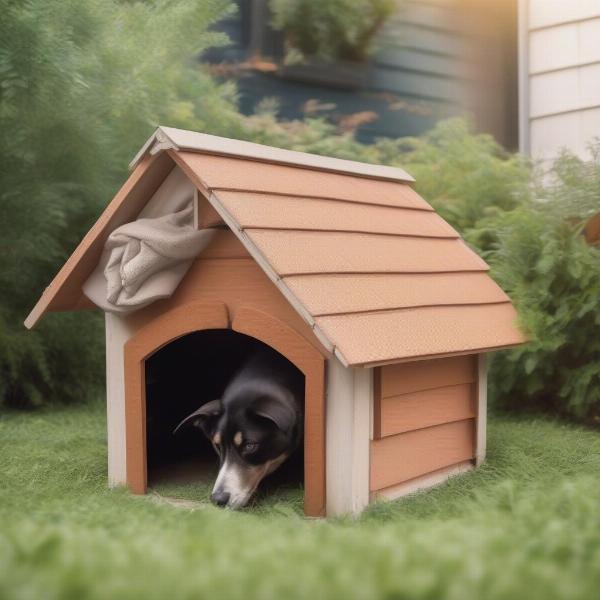A ventilated dog house is essential for your furry friend’s well-being, especially during warmer months. Providing a cool, comfortable shelter protects your dog from overheating and ensures they have a safe space to retreat to. Choosing the right ventilated dog house involves considering factors like size, material, ventilation features, and placement. This article will guide you through everything you need to know about selecting and maintaining the perfect ventilated dog house for your beloved companion.
Choosing the Right Ventilated Dog House
Selecting the perfect ventilated dog house involves several key considerations. Your dog’s breed, size, and the local climate play a crucial role. A larger dog will obviously need a larger house, while dogs in hotter climates will benefit from maximum ventilation.
Size and Breed Considerations
Ensure the dog house is spacious enough for your dog to stand, turn around, and lie down comfortably. A house that’s too small will trap heat, negating the benefits of ventilation. Conversely, an overly large house won’t retain enough warmth in colder weather. Consider your dog’s projected adult size if you’re purchasing a house for a puppy.
Material and Ventilation Features
Look for dog houses made from breathable materials like wood or plastic. Elevated floors promote airflow beneath the house, preventing moisture buildup. Features like windows, vents, and screened doors enhance cross-ventilation, allowing for optimal air circulation. Consider a dog house with adjustable vents for customized airflow depending on the weather.
Placement for Optimal Airflow
Position the dog house in a shaded area, preferably under a tree or awning, to minimize direct sunlight. Ensure the entrance isn’t facing the prevailing wind, which can force rain or cold air inside. A slightly elevated location can improve drainage and airflow.
Maintaining Your Ventilated Dog House
Regular maintenance is essential to ensure your dog’s house remains a comfortable and sanitary haven.
Cleaning and Hygiene
Clean the dog house regularly to prevent the buildup of dirt, bacteria, and parasites. Remove bedding and wash it frequently. Use a pet-safe disinfectant to clean the interior and exterior surfaces.
Weatherproofing
Protect the dog house from the elements by applying a weatherproof sealant annually. This will help prevent moisture damage and prolong the life of the house. Consider adding insulation during colder months to help retain heat.
Pest Control
Regularly check for signs of pests like fleas, ticks, and rodents. Use pet-safe pest control methods to prevent infestations.
 Checking for Pests in Dog House
Checking for Pests in Dog House
Is a Ventilated Dog House Necessary?
Yes, a ventilated dog house is crucial, especially in warmer climates. It provides a safe, temperature-regulated space for your dog to escape the heat and other weather conditions. Proper ventilation prevents overheating and promotes a comfortable environment.
What is the best material for a ventilated dog house?
Wood and plastic are popular choices for ventilated dog houses. Wood offers good insulation and breathability, while plastic is durable, easy to clean, and resistant to moisture.
How do I improve ventilation in my dog house?
Adding windows, vents, and screened doors can significantly improve ventilation. Elevating the floor and positioning the house in a shaded area also promotes airflow.
Conclusion
Investing in a well-ventilated dog house is a crucial aspect of responsible dog ownership. By carefully considering size, material, ventilation features, placement, and regular maintenance, you can ensure your furry friend has a comfortable, safe, and healthy haven all year round. A ventilated dog house isn’t just a shelter; it’s an investment in your dog’s well-being.
FAQ
- How often should I clean my dog’s house? Clean the dog house at least once a month, and more frequently if it becomes soiled.
- What type of bedding is best for a ventilated dog house? Choose breathable bedding materials like straw, cedar shavings, or washable dog beds.
- Can I insulate a ventilated dog house? Yes, you can add insulation during colder months, but ensure it doesn’t block ventilation.
- How do I prevent my dog’s house from overheating? Place the house in a shaded area and ensure adequate ventilation through windows, vents, and an elevated floor.
- Where can I find high-quality ventilated dog houses? Pet supply stores, online retailers, and specialty dog house manufacturers offer a variety of options.
- Are there DIY options for building a ventilated dog house? Yes, many resources are available online with detailed instructions for building your own dog house.
- How can I make my existing dog house more ventilated? Adding vents, windows, or raising the floor can significantly improve ventilation in an existing dog house.
ILM Dog is your trusted resource for all things dog-related. We offer expert advice on dog breeds, health, training, nutrition, grooming, and much more. From choosing the right breed to understanding your dog’s behavioral needs, ILM Dog is here to support you every step of the way. For further assistance or to explore our wide range of products and services, connect with us via email at [email protected] or call us at +44 20-3965-8624. ILM Dog is dedicated to helping you provide the best possible care for your canine companion.